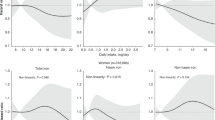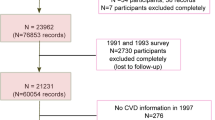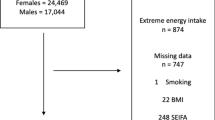Abstract
Objectives:
To describe the intake of the fat-soluble nutrients retinol, β-carotene, vitamin E and vitamin D and their food sources among 27 redefined centres in 10 countries participating in the European Prospective Investigation into Cancer and Nutrition (EPIC) study.
Methods:
Between 1995 and 2000, 36 034 subjects (age range: 35–74 years) completed a single standardized 24-h dietary recall using a computerized interview software program (EPIC-SOFT). Intakes of the fat-soluble nutrients were estimated using the standardized EPIC Nutrient Database.
Results:
For all the nutrients, in most centres, men had a higher level of intake than did women, even after adjustments for total energy intake and anthropometric confounders. Distinct regional gradients from northern to southern European countries were observed for all nutrients. The level intake of β-carotene and vitamin E also showed some differences by level of education, smoking status and physical activity. No meaningful differences in the nutrient intake were observed by age range.
Conclusions:
These results show differences by study centre, gender, age and various lifestyle variables in the intake of retinol, β-carotene, vitamin E and vitamin D between 10 European countries.
This is a preview of subscription content, access via your institution
Access options
Subscribe to this journal
Receive 12 print issues and online access
$259.00 per year
only $21.58 per issue
Buy this article
- Purchase on Springer Link
- Instant access to full article PDF
Prices may be subject to local taxes which are calculated during checkout



Similar content being viewed by others
References
Agudo A, Slimani N, Ocke MC, Naska A, Miller AB, Kroke A et al. (2002). Consumption of vegetables, fruit and other plant foods in the European Prospective Investigation into Cancer and Nutrition (EPIC) cohorts from 10 European countries. Public Health Nutr 5, 1179–1196.
Al-Delaimy WK, van Kappel AL, Ferrari P, Slimani N, Steghens JP, Bingham S et al. (2004). Plasma levels of six carotenoids in nine European countries: Report from the European Prospective Investigation into Cancer and Nutrition (EPIC). Public Health Nutr 7, 713–722.
Al-Delaimy WK, Ferrari P, Slimani N, Pala V, Johansson I, Nilsson S et al. (2005a). Plasma carotenoids as biomarkers of intake of fruits and vegetables: individual-level correlations in the European Prospective Investigation into Cancer and Nutrition (EPIC). Eur J Clin Nutr 59, 1387–1396.
Al-Delaimy WK, Slimani N, Ferrari P, Key T, Spencer E, Johansson I et al. (2005b). Plasma carotenoids as biomarkers of intake of fruits and vegetables: ecological-level correlations in the European Prospective Investigation into Cancer and Nutrition (EPIC). Eur J Clin Nutr 59, 1397–1408.
Ali MM, Vaidya V (2007). Vitamin D and cancer. J Cancer Res Ther 3, 225–230.
Bingham S, Riboli E (2004). Diet and cancer—the European Prospective Investigation into Cancer and Nutrition. Nat Rev Cancer 4, 206–215.
Bjelakovic G, Nikolova D, Gluud LL, Simonetti RG, Gluud C (2008). Antioxidant supplements for prevention of mortality in healthy participants and patients with various diseases. Cochrane Database Systematic Review 2, CD007176.
Brustad M, Skeie G, Braaten T, Slimani N, Lund E (2003). Comparison of telephone vs face-to-face interviews in the assessment of dietary intake by the 24 h recall EPIC SOFT program—the Norwegian calibration study. Eur J Clin Nutr 57, 107–113.
Brustad M, Alsaker E, Engelsen O, Aksnes L, Lund E (2004). Vitamin D status of middle-aged women at 65–71 degrees N in relation to dietary intake and exposure to ultraviolet radiation. Public Health Nutr 7, 327–335.
Constantinou C, Papas A, Constantinou AI (2008). Vitamin E and cancer: an insight into the anticancer activities of vitamin E isomers and analogs. Int J Cancer 123, 739–752.
Debier C, Larondelle Y (2005). Vitamins A and E: metabolism, roles and transfer to offspring. Br J Nutr 93, 153–174.
Dunnigan MG, Henderson JB, Hole DJ, Barbara ME, Berry JL (2005). Meat consumption reduces the risk of nutritional rickets and osteomalacia. Br J Nutr 94, 983–991.
Fairfield KM, Fletcher RH (2002). Vitamins for chronic disease prevention in adults: scientific review. JAMA 287, 3116–3126.
Giovannucci E (2007). Epidemiological evidence for vitamin D and colorectal cancer. J Bone Miner Res 22 (Suppl 2), V81–V85.
Giovannucci E (2008). Vitamin D status and cancer incidence and mortality. Adv Exp Med Biol 624, 31–42.
Goodman GE, Alberts DS, Meyskens FL (2008). Retinol, vitamins, and cancer prevention: 25 years of learning and relearning. J Clin Oncol 26, 5495–5496.
Harris S (2008). Emerging roles of vitamin D: more reasons to address widespread vitamin D insufficiency. Mol Aspects Med 29, 359–360.
Heaney RP (2008). Vitamin D: criteria for safety and efficacy. Nutr Rev 66, S178–S181.
Holick MF (2002). Vitamin D: the underappreciated D-lightful hormone that is important for skeletal and cellular health. Curr Opin Endocrinol Diabetes 9, 87–98.
Holick MF (2005). The vitamin D epidemic and its health consequences. J Nutr 135, 2739S–2748S.
Holick MF (2007). Vitamin D deficiency. N Engl J Med 357, 266–281.
Jenab M, Riboli E, Ferrari P, Friesen M, Sabate J, Norat T et al. (2006). Plasma and dietary carotenoid, retinol and tocopherol levels and the risk of gastric adenocarcinomas in the European prospective investigation into cancer and nutrition. Br J Cancer 95, 406–415.
Kimlin MG (2008). Geographic location and vitamin D synthesis. Mol Aspects Med 29, 453–461.
Linseisen J, Bergstrom E, Gafa L, Gonzalez CA, Thiebaut A, Trichopoulou A et al. (2002a). Consumption of added fats and oils in the European Prospective Investigation into Cancer and Nutrition (EPIC) centres across 10 European countries as assessed by 24-hour dietary recalls. Public Health Nutr 5, 1227–1242.
Linseisen J, Kesse E, Slimani N, Bueno-De-Mesquita HB, Ocke MC, Skeie G et al. (2002b). Meat consumption in the European Prospective Investigation into Cancer and Nutrition (EPIC) cohorts: results from 24-hour dietary recalls. Public Health Nutr 5, 1243–1258.
Linseisen J, Rohrmann S, Norat T, Gonzalez CA, Dorronsoro IM, Morote GP et al. (2006). Dietary intake of different types and characteristics of processed meat which might be associated with cancer risk–results from the 24-hour diet recalls in the European Prospective Investigation into Cancer and Nutrition (EPIC). Public Health Nutr 9, 449–464.
Love JM, Gudas LJ (1994). Vitamin A, differentiation and cancer. Curr Opin Cell Biol 6, 825–831.
Marceau G, Gallot D, Lemery D, Sapin V (2007). Metabolism of retinol during mammalian placental and embryonic development. Vitam Horm 75, 97–115.
McCullough FS, Northrop-Clewes CA, Thurnham DI (1999). The effect of vitamin A on epithelial integrity. Proc Nutr Soc 58, 289–293.
Miller III ER, Pastor-Barriuso R, Dalal D, Riemersma RA, Appel LJ, Guallar E (2005). Meta-analysis: high-dosage vitamin E supplementation may increase all-cause mortality. Ann Intern Med 142, 37–46.
Mullie P, Gandini S, Boniol M, Autier P (2008). Latitude of residence in Europe and serum 25-hydroxy vitamin D levels: a systematic review. In: Vitamin D and Cancer. IARC Working Group Reports, vol. 5. WHO-International Agency for Research on Cancer, Lyon. pp 201–210.
Nesby-O'Dell S, Scanlon KS, Cogswell ME, Gillespie C, Hollis BW, Looker AC et al. (2002). Hypovitaminosis D prevalence and determinants among African American and white women of reproductive age: third National Health and Nutrition Examination Survey, 1988–1994. Am J Clin Nutr 76, 187–192.
Palace VP, Khaper N, Qin Q, Singal PK (1999). Antioxidant potentials of vitamin A and carotenoids and their relevance to heart disease. Free Radic Biol Med 26, 746–761.
Riboli E, Kaaks R (1997). The EPIC Project: rationale and study design. European Prospective Investigation into Cancer and Nutrition. Int J Epidemiol 26 (Suppl 1), S6–S14.
Riboli E, Hunt KJ, Slimani N, Ferrari P, Norat T, Fahey M et al. (2002). European Prospective Investigation into Cancer and Nutrition (EPIC): study populations and data collection. Public Health Nutr 5, 1113–1124.
Singh U, Devaraj S, Jialal I (2005). Vitamin E, oxidative stress, and inflammation. Annu Rev Nutr 25, 151–174.
Skeie G, Braaten T, Hjartåker A, Lentjes M, Amiano P, Jakszyn P et al. (2009). Use of dietary supplements in the European Prospective Investigation into Cancer and Nutrition calibration study. Eur J Clin Nutr 63 (Suppl 4), S226–S238.
Slimani N, Deharveng G, Charrondiere RU, van Kappel AL, Ocke MC, Welch A et al. (1999). Structure of the standardized computerized 24-h diet recall interview used as reference method in the 22 centers participating in the EPIC project. European Prospective Investigation into Cancer and Nutrition. Comput Methods Programs Biomed 58, 251–266.
Slimani N, Ferrari P, Ocke M, Welch A, Boeing H, Liere M et al. (2000). Standardization of the 24-h diet recall calibration method used in the European prospective investigation into cancer and nutrition (EPIC): general concepts and preliminary results. Eur J Clin Nutr 54, 900–917.
Slimani N, Kaaks R, Ferrari P, Casagrande C, Clavel-Chapelon F, Lotze G et al. (2002a). European Prospective Investigation into Cancer and Nutrition (EPIC) calibration study: rationale, design and population characteristics. Public Health Nutr 5, 1125–1145.
Slimani N, Fahey M, Welch AA, Wirfalt E, Stripp C, Bergstrom E et al. (2002b). Diversity of dietary patterns observed in the European Prospective Investigation into Cancer and Nutrition (EPIC) project. Public Health Nutr 5, 1311–1328.
Slimani N, Deharveng G, Unwin I, Southgate DA, Vignat J, Skeie G et al. (2007). The EPIC nutrient database project (ENDB): a first attempt to standardize nutrient databases across the 10 European countries participating in the EPIC study. Eur J Clin Nutr 61, 1037–1056.
Sommer A (2008). Vitamin A deficiency and clinical disease: an historical overview. J Nutr 138, 1835–1839.
Traber MG, Atkinson J (2007). Vitamin E, antioxidant and nothing more. Free Radic Biol Med 43, 4–15.
van der Wielen RP, Lowik MR, van den BH, de Groot LC, Haller J, Moreiras O et al. (1995). Serum vitamin D concentrations among elderly people in Europe. Lancet 346, 207–210.
Voutilainen S, Nurmi T, Mursu J, Rissanen TH (2006). Carotenoids and cardiovascular health. Am J Clin Nutr 83, 1265–1271.
Wallis DE, Penckofer S, Sizemore GW (2008). The ‘sunshine deficit’ and cardiovascular disease. Circulation 118, 1476–1485.
Welch AA, Lund E, Amiano P, Dorronsoro M, Brustad M, Kumle M et al. (2002). Variability of fish consumption within the 10 European countries participating in the European Investigation into Cancer and Nutrition (EPIC) study. Public Health Nutr 5, 1273–1285.
Yetley EA (2008). Assessing the vitamin D status of the US population. Am J Clin Nutr 88, 558S–564S.
Zittermann A, Schleithoff SS, Koerfer R (2005). Putting cardiovascular disease and vitamin D insufficiency into perspective. Br J Nutr 94, 483–492.
Acknowledgements
The work described in this paper was carried out with the financial support of the European Commission: Public Health and Consumer Protection Directorate 1993–2004; Research Directorate-General 2005; Ligue contre le Cancer (France); Société 3M (France); Mutuelle Générale de l’Education Nationale; Institut National de la Santé et de la Recherche Médicale (INSERM); Institut Gustave Roussy; German Cancer Aid; German Cancer Research Center; German Federal Ministry of Education and Research; Danish Cancer Society; Health Research Fund (FIS) of the Spanish Ministry of Health; Spanish Regional Governments of Andalucía, Asturias, Basque Country, Murcia and Navarra and the Catalan Institute of Oncology; and ISCIII RETIC (RD06/0020), Spain; Cancer Research UK; Medical Research Council, UK; the Stroke Association, UK; British Heart Foundation; Department of Health, UK; Food Standards Agency, UK; the Wellcome Trust, UK; Greek Ministry of Health; Hellenic Health Foundation; Italian Association for Research on Cancer; Italian National Research Council, Regione Sicilia (Sicilian government); Associazione Iblea per la Ricerca Epidemiologica - ONLUS (Hyblean association for epidemiological research, NPO); Dutch Ministry of Health, Welfare and Sport; Dutch Prevention Funds; LK Research Funds; Dutch ZON (Zorg Onderzoek Nederland); World Cancer Research Fund (WCRF); Swedish Cancer Society; Swedish Research Council; Regional Government of Skane and the County Council of Vasterbotten, Sweden; Norwegian Cancer Society; the Norwegian Research Council and the Norwegian Foundation for Health and Rehabilitation. We thank Sarah Somerville, Nicole Suty and Karima Abdedayem for their assistance with editing and Kimberley Bouckaert and Heinz Freisling for their technical assistance.
Author information
Authors and Affiliations
Corresponding author
Additional information
Guarantors: M Jenab.
Contributors: MJ carried out the statistical analysis, preparation of tables and figures, and wrote the paper, taking into account the comments from all co-authors. NS was the overall coordinator of this project and the EPIC Nutrient Database project. CB assisted in the statistical analysis and preparation of the tables and figures. SS, CHvG, MB, SS-S, BB, HV, MT, CB and PW were members of the writing group and gave inputs on the statistical analysis, drafting of the manuscript and interpretation of the results. EL, MW, NR, AMJ, JL, HB, EV, VD, SS, CS, PF, JM, SN, AAW, RT, MCB-R, MN, HBB-de-M, YTvdS, MJT, AB, ER and SB were local EPIC collaborators involved in the collection of dietary and other data, and contributed to the ENDB project. ER is the overall coordinator of the EPIC study. All co-authors provided comments and suggestions on the paper and approved the final version.
Appendix
Appendix
Rights and permissions
About this article
Cite this article
Jenab, M., Salvini, S., van Gils, C. et al. Dietary intakes of retinol, β-carotene, vitamin D and vitamin E in the European Prospective Investigation into Cancer and Nutrition cohort. Eur J Clin Nutr 63 (Suppl 4), S150–S178 (2009). https://doi.org/10.1038/ejcn.2009.79
Published:
Issue Date:
DOI: https://doi.org/10.1038/ejcn.2009.79
Keywords
This article is cited by
-
Factors associated with serum 25-hydroxyvitamin D concentrations in older people in Europe: the EUREYE study
European Journal of Clinical Nutrition (2019)
-
Dietary vitamin a intake among Chinese adults: findings from CNTCS2015
Nutrition Journal (2018)
-
Longitudinal associations between lifestyle and vitamin D: A general population study with repeated vitamin D measurements
Endocrine (2016)
-
Does the consumption of fruits and vegetables differ between Eastern and Western European populations? Systematic review of cross-national studies
Archives of Public Health (2015)
-
Low serum concentrations of alpha-tocopherol are associated with increased risk of hip fracture. A NOREPOS study
Osteoporosis International (2014)



